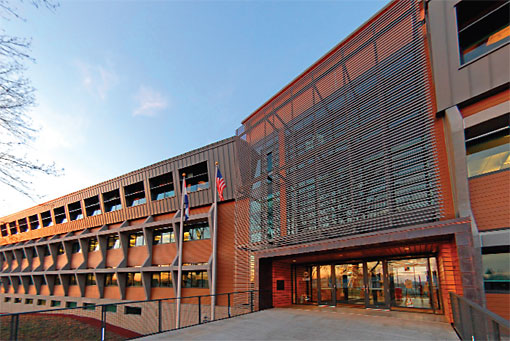| 제목 | [DAIKIN] GOVERNMENT - Lewis-Clark State | 작성일 | 16-06-16 14:23 |
| 글쓴이 | 최고관리자 | 조회수 | 2,919 |
본문
CASE STUDY
Office Building
Name
Lewis and Clark State Office Building
Location
Jefferson City, MO USA
Facility Size
120,000 ft2
HVAC System Type
24 custom configured Vision® air handlers and two model WSC high-efficiency centrifugal chillers
Solution
Annual energy savings of about $90,000 over conventional buildings
of similar size, LEED® Platinum certification
Daikin helps Lewis and Clark Administration Building discover first LEED® Platinum certification for state office buildings
In the spirit of the explorers after whom it is named, the Lewis and Clark State Office Building in Jefferson City, Missouri, has charted new territory. The facility is one of only 16 buildings in the nation – and the first state office building – to receive a Platinum certification, the highest rating in the LEED-New Construction (NC) Version 2.1 program administered by the U.S. Green Building Council (USGBC). Innovative air conditioning components manufactured by Daikin – including 24 custom configured Vision air handlers and two model WSC high-efficiency centrifugal chillers – contributed significantly to the achievement.
Building elements create design synergies
Commissioned in 2004, the Lewis and Clark Building provides 120,000 ft2 of office space for Missouri's Department of Natural Resources on a site overlooking the Missouri River.
According to Laura Lesniewski, architect and project manager with BNIM Architects in Kansas City, Missouri, many synergies resulting from the architectural and engineering decisions contributed to the building's energy efficiency.
"The building's long and narrow footprint is oriented along a long east-west axis (350 feet), which allows us to better control the amount of daylight and solar heat gain that enters the building – blocking it in the summer and accepting it in the winter. The narrow east and west faces (about 70 feet) reduce heat gain from the intense afternoon sun in the summer. In addition, external sun shades over the south-facing windows help reduce the load on the air conditioning system. Internal light shelves just below the clerestory windows reflect light up onto the ceiling and, from there, deep into the building's interior. We chose low-E glass to let in light, but reflect heat away from the building; daylight sensors throughout the building automatically turn off lights when there is enough natural light."
Other important design features that save energy include:
- ▶ Ceiling-to-waist-level windows versus the more common floor-to-ceiling
- ▶ Operable windows that allow workers to bring in "free" fresh air when available
- ▶ Photovoltaic panels on the roof that generate about 2.5 percent of needed energy
- ▶ Chilled water for air conditioning that is generated at night and stored in a cistern under the building for use during the day
-
Wherever possible, the energy-saving features of the building are visibly expressed to educate the public about green building strategies.
Energy costs are 60 percent lower than ASHRAE standard
Lesniewski says the Lewis and Clark Building design team aimed for Gold level certification (see sidebar: "Green Design and LEED: Creating Synergies"), adding, "The fact that we achieved Platinum reflects the incredible team effort by the owner group and the entire design and construction team." To achieve the Platinum rating, the building fulfilled 53 points. Fifteen of these - 28% of all points awarded - were in the Energy and Atmosphere (EA) category, which takes into account the integrated performance of the building's envelope and its mechanical and electrical systems.
Of the 15 points in the EA category, 10 out of a possible 10 were earned for EA Credit 1 – Optimize Energy Performance. In doing so, the design team demonstrated that the building required 60 percent less in energy cost than a comparably designed building that just met the requirements of ASHRAE Standard 90.1-2004.
Under-floor air distribution system
One of the design team's key decisions was to choose an underfloor air distribution (UFAD) system. A UFAD system delivers air through floor-mounted diffusers in a plenum formed by a floor raised above the concrete slab. This produces a floor-to-ceiling air flow that takes advantage of the natural buoyancy produced by heat sources in the office; even cooled air is eventually pushed up. This results in relatively uniform air temperatures in the space where people actually work - from the floor to a height of about six feet.
Daikin Vision indoor air handlers are an essential part of the UFAD system. Custom-modular flexibility is the fundamental idea behind Vision air-handling units. It allows specifying engineers to size the unit's cabinet on two-inch size increments for both height and width without limiting the component selections available to meet the requirements of the application. That allowed the Lewis and Clark design team to specify 24 air handlers of varying sizes with no need for custom fabricated equipment.
Placing the air handlers around the building contributed to significant savings in duct work. Daikin Applications Manager Jay Eldridge says, "You can supply as much energy around a building using two-inch chilled water pipes as you get with 40-inch ducts." Peter Rumsey, principal, Rumsey Engineers, Oakland, CA, whose company designed the HVAC systems, adds, "All those air handlers placed around the building mean reducing the fan energy loading, resulting in a pressure drop that is about one-third of what you find in the typical system."
The efficiency of the Vision air handlers in the UFAD system ultimately reduces the load on all other components of the HVAC system – including the chillers. The design team specified two Daikin WSC high efficiency centrifugal chillers for their energy-efficient operation. The compressor unloads down to 10 percent of full load without hot gas bypass. Variable speed drives contribute to the chiller's superior part load efficiency. In addition, the chillers earned one point for EA Credit 4 – ozone depletion – because they use HFC-134a refrigerant with no ozone depletion potential or phase-out schedule. Although each component is designed for efficiency, it is the overall efficiency of the HVAC system integrated with green building design that delivered so many LEED-NC points – and so much in energy savings – in the Lewis and Clark building. Rumsey estimates that about 60 percent of the building's overall efficiency is derived from the innovative HVAC system design, and about 40 percent from lighting and architectural considerations.
Additional points for IEQ
The Lewis and Clark building received additional LEED points in the Indoor Environmental Quality (IEQ) category. One was for its overall indoor air quality plan, a key factor of which is the use of MERV- 13 filters (MERV = minimum efficiency reporting value). With appropriate air flow characteristics, MERV-13 filters are capable of removing mold spores and bacteria from indoor air. However, the efficiency of the filters places a greater load on the HVAC system. The flexibility of the Vision air handlers allowed designers to exactly match the equipment to the air-flow requirements to accommodate the extra load imposed by the filters.
Yet another IEQ point was earned for the building's CO2 monitoring system, which indicates the actual real-time load placed on the HVAC system by building occupants. This information is used to control heating and cooling levels and is translated into additional savings on energy bills.
Discovering the benefits of green territory
With annual energy savings of about $90,000 over conventional buildings of similar size, the Lewis and Clark building carries on the tradition of its namesakes by exploring new horizons in sustainable building design.
Green Design and LEED: Creating Synergies
The LEED (Leadership in Energy and Environmental Design) Green Building Rating System is a voluntary standard, established by the U.S. Green Building Council in 1999, and widely recognized as a third-party verification system and guideline for measuring what constitutes a green building. LEED describes its goal as helping professionals across the country to improve the quality of buildings and their impact on the environment. Many federal and state government offices are strong supporters of the LEED program and require LEED certification where possible.
A LEED-certified building means it has achieved at least a minimum standard as judged in six categories: sustainable sites; water efficiency; energy and atmosphere; materials and resources; indoor environmental quality; and innovation and design process. Points are awarded in each category, depending on how the facility meets each category's requirements. A building must receive a minimum of 26 points for LEED certification; up to 69 points are possible. There are four levels of LEED certification: Certified (26-32 points); Silver (33-38 points); Gold (39-51 points); and Platinum (52-69 points).
Synergy is the key to accumulating the most points: understanding how each system affects the others and where to get the most trade-off between credits. For example, decreasing the indoor lighting required in a space (by adding more natural daylight) helps reduce the size and operating cost of the air conditioning system required. Less lighting means less heat gain, which means less energy is required to cool the space.
The Energy and Atmosphere category-one third of potential LEED points directly addresses the HVAC system and its impact on the environment. This includes the amount of energy the HVAC system consumes, the environmental impact of generating that energy, and the refrigerant used in the equipment. Once a building has met three prerequisites (for fundamental building systems commissioning, minimum energy performance and fundamental refrigerant management), LEED-New Construction provides up to 10 points for the percentage of energy cost savings beyond the minimum required in the prerequisite. A computer simulation model or energy analyzing software can help assess the energy performance of a building's design and identify the most cost-effective energy efficiency measures.
For more information about the LEED certification program see www.usgbc.org. For specific information on LEED and its impact on HVAC systems, visit the GreenWay® Resource Center at www.DaikinApplied.com.
| 이전글 | [DAIKIN] GOVERNMENT - Federal Hall National Memorial 2016-06-16 | ||
| 다음글 | [DAIKIN] GOVERNMENT - Queen Creek Library 2016-06-16 | ||






